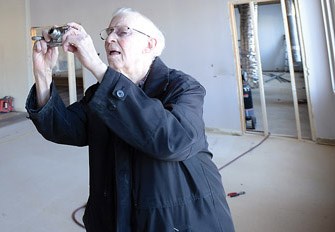In the 1960s, architect Trelle Morrow changed the shape of learning in Prince George.
Now one of the schools he designed will be recognized on the city's heritage register, to commemorate what he calls an "experimental school." School District 57 voted unanimously to grant the school the designation following a presentation by Morrow and city planner Katie Fabris on Tuesday evening.
Quinson elementary was designed to feature five-sided, or pentagonal, classrooms, as well as a six-sided gym. The unorthodox design came as a result of a change in teaching methods brought about by then-superintendent David Todd and administrator Allan Stables.
"School officials from the 1950s were very interested in adapting schools to better students conditions, better teaching conditions," said Morrow.
Many educators at the time felt that the rectangular shape of classrooms, still largely in use today, fostered an environment in which the focus point was the teacher, as an authority figure.
"The thinking was that the teacher should be more fluid in the eyes of the student," said Morrow.
The early 1960s were a period of rapid expansion in Prince George. Then-B.C. Premier W.A.C. Bennett made development of the north a key priority. The pulp industry was booming, and the resulting increase in the city's population brought further demands on regional schools.
"The schools were really up against it. Immediately they had to build schools to accommodate the kids that were flooding into the area," Morrow said.
The gymnasium design at Quinson, with its increased space for risers, proved to be particularly popular. Six subsequent schools built by School District 57 - Mackenzie elementary, Blackburn elementary, Carney Hill elementary, Austin Road elementary, Highlands elementary and Spruceland elementary - utilized this design for their gymnasiums. The classroom design of Quinson proved less popular.
"The pentagonal classroom was abandoned in favour of multiple teaching or group teaching," Morrow said. "They went back to their rectangular classroom areas and they put in folding walls."
The motion to place the school on the heritage register came after a recommendation from the city's heritage commission, of which Morrow is a member. According to Fabris, placing Quinson elementary on the heritage register will ensure that the school will be flagged in a City of Prince George heritage database but will not necessarily prevent maintenance or further development of the school.
"It allows the property owner or, in this case the school, to still do work and alter the building and maintain the building as they need to, but it does flag them of that information," Fabris said, following her presentation to District 57 on Tuesday night.
"The commission would encourage them to do those alterations and do that maintenance in conjunction with the character defining features," Fabris said.
According to Fabris, no other schools are currently being considered for addition to the city's heritage register.



